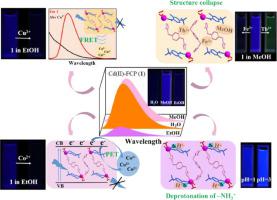Journal of Molecular Structure ( IF 4.0 ) Pub Date : 2022-03-09 , DOI: 10.1016/j.molstruc.2022.132802 Min Yan , Tingjun Gu , Shengyang Yang , Kou-Lin Zhang

|
Herein, the assembly between the multi-functional 2-amino-4-sulfonyl-benzoic acid (H2asba) and Cd(II) in the presence of the hydrophobic ligand 4-bis[(2-methyl-1H-imidazole-1-yl)methyl]benzene (2-mmzm) results in a novel hydrolytically stable 1D Cd(II)-FCP, {[Cd(asba)(2-mmzm)(H2O)2]•3H2O}n (1). The water tetramer-based hydrogen-bonded ring R22(8) bridges the chains into a 2D supramolecular layer. The novel discrete water decamer further links the layers into a 3D supramolecular network. 1 shows extremely acidic and basic resistance in a wide pH range of 1.0-12.0. More importantly, 1 exhibits accurate sensing of pH of the artificial gastric juices. Interestingly, 1 demonstrates solvent-dependent multi-responsive fluorescence sensing behavior to metal ions. 1 can sense Fe3+/Cu2+/Tb3+ in water, Fe3+/Cu2+/Tb3+/Co2+ in MeOH and Fe3+/Cu2+/Tb3+/Co2+/Ba2+ in ethanol, respectively. The fluorescence sensing of 1 toward Fe3+/Tb3+/Ba2+ is resulted from the structural collapse in the corresponding solvents. However, 1 keeps integrity and shows higher chemical resistance to Cu2+ and Co2+ in the corresponding solvents. The fluorescence sensing of Cu2+ can be ascribed to the photo-induced electron transfer (PET) and fluorescence resonance energy transfer (FRET) mechanism. The sensing of Co2+ can be attributed to the PET mechanism. The solvents have great influence on the sensing sensitivities to Cu2+ and Co2+. 1 shows the highest sensing sensitivity to Cu2+ and Co2+ in ethanol.
中文翻译:

一种新型水解稳定的荧光 Cd(II) 配位聚合物,对 pH 值和一些金属离子表现出溶剂依赖性多响应荧光传感
在此,在疏水配体 4-bis[(2-methyl-1H-imidazole-1) 存在下,多功能 2-amino-4-sulfonyl-benzoic acid (H 2 asba) 和 Cd(II) 之间的组装-yl)methyl]benzo (2-mmzm) 产生一种新型水解稳定的一维 Cd(II)-FCP,{[Cd(asba)(2-mmzm)(H 2 O) 2 ]•3H 2 O} n ( 1 )。基于水四聚体的氢键环 R 2 2 (8) 将链桥接成二维超分子层。新颖的离散水十聚体进一步将这些层连接成一个 3D 超分子网络。 1在 1.0-12.0 的宽 pH 范围内显示出极强的耐酸性和耐碱性。更重要的是,1展示了对人工胃液 pH 值的准确感应。有趣的是,1展示了对金属离子的溶剂依赖性多响应荧光传感行为。1可以感应水中的Fe 3+ /Cu 2+ / Tb 3+ , MeOH中的Fe 3+ /Cu 2+ /Tb 3+ / Co 2+和Fe 3+ /Cu 2+ /Tb 3+ /Co 2+ /Ba 2+分别在乙醇中。1对Fe 3+ /Tb 3+ /Ba 2+的荧光传感是由于相应溶剂中的结构坍塌造成的。然而,1保持完整性,并在相应的溶剂中对 Cu 2+和 Co 2+表现出更高的耐化学性。Cu 2+的荧光传感可归因于光诱导电子转移(PET)和荧光共振能量转移(FRET)机制。Co 2+的感测可归因于PET机制。溶剂对Cu 2+和Co 2+的传感灵敏度影响很大。图1显示了对乙醇中Cu 2+和Co 2+的最高传感灵敏度。






























 京公网安备 11010802027423号
京公网安备 11010802027423号